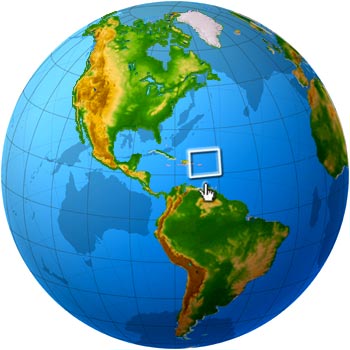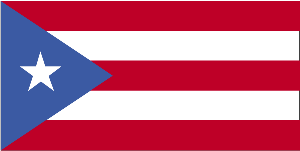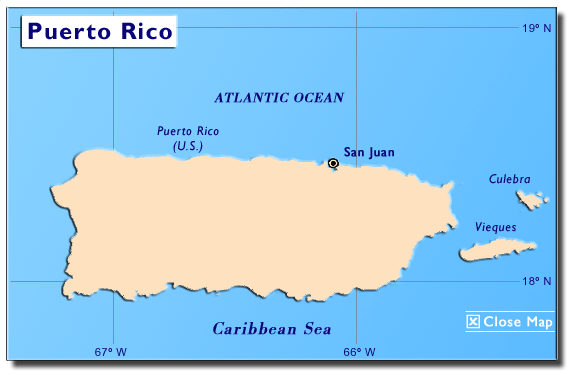Geography
 Puerto Rico is part of the Greater Antilles and is situated
east of the Dominican Republic between the Caribbean Sea and
the Atlantic Ocean (Rivera, 2005a).
Puerto Rico is part of the Greater Antilles and is situated
east of the Dominican Republic between the Caribbean Sea and
the Atlantic Ocean (Rivera, 2005a).
In
territorial size, Puerto Rico is about 3,500 square miles
(9,100 square kilometers, or slightly less than three times
the size of Rhode Island). Its terrain is mostly mountainous,
although there is a coastal plain in the north and sandy beaches
along most of its coast (Rivera, 2005a). It is very strategically
located along the Mona Passage, which leads to the Panama
Canal. Many small rivers ensure that fresh water is plentiful
and the natural harbor in San Juan is one of the largest in
the Caribbean. The capital is the city of San
Juan.
Climate
The climate of Puerto Rico is best described as “mild
tropical” with few seasonal variations in temperature.
The temperatures average about 80° F (26°C) most of
the year. Humidity is high, but winds from the east keep the
temperature moderate (Rivera, 2005a). The archipelago is vulnerable
to occasional hurricanes, but less so than some of the other
Caribbean islands (Puerto Rico, 2004).

History
As
far back as the 15th century, Taíno
Indians inhabited Puerto Rico (History of Puerto Rico,
2004). The Taíno Indians were originally from South
America. They were a peaceful people who lived in small villages.
Their lives changed dramatically when, in 1493, Christopher
Columbus, on his second voyage to the New World, claimed the
land for the King and Queen of Spain (Shoendorf, 2000). When
the Spanish discovered gold, they enslaved the Taínos
and mistreated them to such an extent that they were virtually
extinct by 1520 (History of Puerto Rico, 2004).
Shortly thereafter, the first African slaves were brought
to support the colonial exploitation of the island. The
Spanish kept the Africans as slaves until the practice
was abolished in 1873 (History of Puerto Rico, 2004). Puerto
Rico continued as a Spanish military outpost for over four
centuries. When the Treaty of Paris was signed at the end
of the Spanish-American War on December 10, 1898, the United
States acquired Puerto Rico. Refugees and European immigrants
settled in Puerto Rico in the early 19th century. Since 1917,
Puerto Ricans have been considered citizens of the United
States. “The contemporary culture of Puerto Rico emerged
from the blending of European, African, and Native American
traditions.” (History of Puerto Rico, 2004).
Political Organization
 The
legal status of Puerto Rico is hard to define. Although the
United States holds ultimate sovereignty over its affairs,
Puerto Rico enjoys a considerable degree of autonomy. As a
commonwealth territory of the United States of America, Puerto
Rico’s citizens are also citizens of the U.S. However,
Puerto Rico has its own constitution (which has been ratified
by the U.S. Congress) and Puerto Rico does not pay U.S. federal
income tax (Puerto Rico, 2005). The
legal status of Puerto Rico is hard to define. Although the
United States holds ultimate sovereignty over its affairs,
Puerto Rico enjoys a considerable degree of autonomy. As a
commonwealth territory of the United States of America, Puerto
Rico’s citizens are also citizens of the U.S. However,
Puerto Rico has its own constitution (which has been ratified
by the U.S. Congress) and Puerto Rico does not pay U.S. federal
income tax (Puerto Rico, 2005).
Puerto Rico controls its own internal affairs (in a manner
similar to that of individual U.S. states) and sends its own
team to the Olympic Games (Puerto Rico, 2005). Despite continuous
debate between the various political parties, Puerto Ricans
have voted to continue as a commonwealth of the United States
(Puerto Rico, 2005).

Puerto Rico has three branches of government:
- Executive Branch - The chief of state
is the President of the United States, and the head of the
island’s government is a Governor who is popularly
elected for a four-year term. The present Governor, Anibal
ACEVEDO-VILA since 2 January 2005, succeeded Sila
Maria Calderón, who was the first woman to serve
in this office. She is a firm believer in maintaining the
commonwealth status of Puerto Rico with the U.S. (Sila María
Calderón, 2005).
- The Legislative Branch is comprised of
a bicameral body known as the Legislative Assembly, which
includes the Senate (with 28 members) and the House of Representatives
(54 members). The Assembly is elected every four years.
Puerto Ricans elect a Resident Commissioner every four years
as a nonvoting representative to the U.S. House of Representatives
who functions primarily as a process observer for the Puerto
Rican government (Politics of Puerto Rico, 2004).
- The Judicial Branch is comprised of a
Supreme Court, Appellate Court, and a Court of First Instance
composed of two sections: a Superior Court and a Municipal
Court. The Governor appoints all the judges with the consent
of the Senate. In contrast to the common law system prevalent
in most of the U.S., Puerto Rico’s laws are based
on the Spanish civil code.
Administratively, Puerto
Rico is divided into 78 municipalities, each led by a
mayor and a council elected for 4-year terms (Politics of
Puerto Rico, 2004).
Economy
Puerto Rico’s estimated Gross Domestic Product in
2002 was $71.1 billion (per capita GDP $18,409). In terms
of revenue, agriculture has been outpaced by tourism and other
service-based economic activity, along with industries that
include pharmaceuticals, electronics, apparel, beverage concentrates,
rum, medical instruments, food processing, and cement manufacturing
(Economy of Puerto Rico, 2005). Historically, Puerto Rico’s
duty-free access to U.S. markets and investment by U.S. firms
has created one of the most vibrant and diversified economies
in the Caribbean. However, the repeal of tax incentives and
the recent increase in oil prices have dealt significant blows
to the economy (Rivera, 2005b).
|

